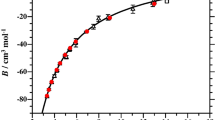Abstract
Original expressions for heat capacity CV and its components, vibrational and configurational components of thermal expansion coefficient were established. The values of CV, Cvib, Cconf, αvib and αconf for water and helium 4He were calculated.
Similar content being viewed by others
References
D. Eisenberg, W. Kauzmann, 1969, The structure and properties of Water, Oxford University Press, Oxford, UK..
N. M. Putintsev, 2005, Heat capacity and thermal expansion of water, Doklady Physical Chemistry, 401 (4), pp. 49–52.
V.A. Kirillin, V.V. Sychev, A.E. Sheindlin, 1983, Engineering Thermodynamics, Energoatomizdat, Moscow.
S.L. Rivkin, A.A. Aleksandrov, E.A. Kremenevskaya, 1978, Thermodynamic derivatives of water and steam, John Wiley & Sons Inc, Washington.
S.L. Rivkin, A.A. Aleksandrov, 1977, Thermophysical properties of water and steam, Energiya, Moscow [in Russian].
A.F. Skryshevskii, 1980, Structural analysis of liquids and amorphous solids, Vysshaya Shkola, Moscow [in Russian].
R.J. Donnelly, C.F. Barenghi, 1998, The observed properties of liquid helium at the saturated vapor pressure, Journal of Physical and Chemical Reference Data, 27 (6), pp. 1217–1274.
J. S. Brooks, R. J. Donnelly, The Calculated Thermodynamic Properties of Superfluid Helium-4. (www: http://pages.uoregon.edu/rjd/table4.htm.- Date of the Application: 23.02. 2012).
V.D. Arp, R.D. McCarty, D. G. Friend, 1998, Thermophysical Properties of Helium-4 from 0.8 to 1500K with Pressures to 2000MPa, NIST Technical Note 1334, (Revised), Gaithersburg, Maryland, USA.
N. M. Putintsev, D. N. Putintsev, 2003, Similarity Points for Molecular Liquids, Doklady Physical Chemistry, 390 (4), pp. 139–142.
N. M. Putintsev, D. N. Putintsev, 2001, A Study of the Structural Properties of Liquid Inert Gases, Doklady Physical Chemistry, 379 (4), pp. 215–217.
Y.E. Gorbatyi, Y.N. Dem’yanets, 1983, X-ray diffraction studies of the structure of the liquid and supercritical water at high temperatures and pressures. II. Radial distribution functions and pair correlation functions, Journal of Structural Chemistry, 24 (3), pp. 385–392.
Y.E. Gorbaty, Y.N. Demianets, 1983, X-ray diffraction studies of the structure of the liquid and supercritical water at high temperatures and pressures. III. The structure of the first coordination sphere, 2 Journal of Structural Chemistry, 4 (5), pp. 74–80.
N. M. Putintsev, D. N. Putintsev, 2014, Calculating the thermodynamic and structural properties of liquid noble gases, Russian Journal of Physical Chemistry A, 88 (3), pp. 353–357.
Author information
Authors and Affiliations
Rights and permissions
About this article
Cite this article
Putintsev, N.M., Putintsev, D.N. Heat capacity and thermal expansion of water and helium. J. Therm. Sci. 26, 125–131 (2017). https://doi.org/10.1007/s11630-017-0920-0
Received:
Published:
Issue Date:
DOI: https://doi.org/10.1007/s11630-017-0920-0




